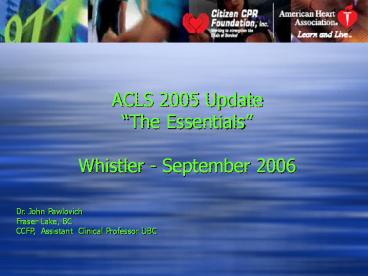ACLS 2005 Update - PowerPoint PPT Presentation
1 / 28
Title:
ACLS 2005 Update
Description:
ACLS 2005 Update 'The Essentials' Whistler - September 2006. Dr. John Pawlovich. Fraser Lake, BC. CCFP, Assistant Clinical Professor UBC. Main Concepts 2005 ACLS ... – PowerPoint PPT presentation
Number of Views:208
Avg rating:3.0/5.0
Title: ACLS 2005 Update
1
ACLS 2005 UpdateThe Essentials Whistler -
September 2006
Dr. John PawlovichFraser Lake, BCCCFP,
Assistant Clinical Professor UBC
2
- Main Concepts 2005 ACLS
3
The 5 major changes in the 2005 guidelines
- improve delivery of effective chest compressions
- single compression-to-ventilation ratio (302)
(except newborns) - each rescue breath should be given over 1 second
to produce visible chest rise - single shock followed by immediate CPR without
pulse or rhythm check for VF/ PVT cardiac arrest - AED use in children (1-8 years)
4
- High-quality CPR saves lives!!
5
Important Points
!
Five key aspectsto Great CPR
6
Coronary Perfusion Pressure (CPP)
- (aortic pressure right atrial pressure)
- MAJOR DETERMINANT FOR SURVIVAL IS CPP
- Highly correlated to ROSC
- When CPR is paused, CPP falls quickly
- When CPR is restarted, it takes 3-6 compressions
to reestablish the previous CPP
7
Compression-Decompression
- Compression
- Compression of heart lungs
- Increased intrathoracic pressure
- Decompression
- Refilling of heart lungs
- Decreased intrathoracic pressure
- Negative with full recoil
8
One Universal Compression-to-Ventilation Ratio
for All Lone Rescuers
- 2005 (New) 302 for all lone rescuers
- 2000 (Old) 152 adults, 51 child and infant.
- Why By-stander CPR is on the order of 30 or
less. Simplify guidelines to increase bystander
CPR.
9
1-Second Breaths During All CPR
- each rescue breath over 1 second to produce chest
rise (Class IIa) - OR 1/3 of BVM volume (500cc) for average adult
given over 1 sec - AVOID HYPERVENTILATION!!
10
Defibrillation (VF/ PVT) 1 Shock, Then Immediate
CPR (NO pulse check, NO rhythm check)
- SINGLE SHOCK MORE CPR
- CONTINUE CPR WHILE MACHINE CHARGES
11
Rationale - 1 Shock followed by Immediate CPR
- The rhythm analysis by current AEDs after each
shock typically results in 37 sec delay in CPR - first shock eliminates VF in more than 85 of
cases. If first shock fails, resumption of CPR
is likely more beneficial - it takes several minutes for a normal heart
rhythm to return and more time for the heart to
create blood flow after VF is eliminated. CPR
can bridge that gap. - Immediate CPR after defibrillation is not harmful.
12
Changes in Advanced Life Support
13
Pulseless Rhythm
14
Main Concept
- priority is good CPR with minimally interruption
- Insertion of an advanced airway not a high
priority - In presence of advanced airway, continuous
compressions (100 per minute) with asynchronous
ventilation (8-10/ min) (1 breath every 6-8
seconds). - minimize interruptions in chest compressions!!!
15
Defibrillation General concept
- Immediate defibrillation if witnessed arrest and
AED available - Compressions before defibrillation if unwitnessed
or arrival at the scene gt4-5 minutes. - One shock followed by immediate CPR (beginning
with chest compressions) - rhythm check after 5 cycles of CPR or 2 minutes
16
Importance of CPRThree-Phase Model
Shock
CPR
?
0
2
4
6
8
10
12
14
16
18
20
Arrest Time (min)
17
Importance of CPRPriming the Pump
18
Defibrillation Energy setting
- For adult defibrillation
- monophasic manual defibrillator 360J
- biphasic with truncated exponential waveform
150-200J - biphasic with rectilinear waveform 120J
- biphasic unknown type 200J.
19
1 shock versus 3 stacked shocks
- BIPHASIC eliminates VF after first shock gt90
- AED requires 90 secs for 3 shocks (i.e. NO CPR
FOR 90 SECONDS) - Interruptions in chest compressions are harmful
- 1 Shock strategy may be preferable
20
Drug Administration
- IV or IO drug administration is preferred to ETT
route - Drugs should be delivered during CPR as soon as
possible after rhythm checks. - timing of drug administration is less important
than the need to minimize interruptions in chest
compressions
21
Major changes in ACLS drugs
- VF/ pVT/ asystole/ PEA
- epinephrine q3-5 min
- Vasopressin X 1 may replace either the first or
second dose of epinephrine. - VF/ pVT
- Amiodarone (Class IIb)
- Lidocaine (indeterminate)
22
Antiarrhythmics
- No evidence that giving any antiarrythmic drug
routinely during cardiac arrest increases rate of
survival to hospital discharge - In comparison with placebo and lidocaine, the use
of amiodarone in shock-refractory VF improves the
short-term outcome of survival to hospital
admission
23
Use of Advanced Airways
- LMA and Combitube should be considered (Class
IIa). - Advanced airway may be placed several minutes
into the resuscitation - clinical assessment plus a device such as ETCO2
or EDD to confirm ETT placement (Class IIa).
24
Bradycardia Tachycardia
25
Arrhythmia with pulse
- symptomatic bradycardia
- atropine 0.5mg IV (max 3mg)
- Isoproterenol eliminated
- Tachycardia
- summarized in a single algorithm
- branch points then become narrow versus wide
complex, and regular versus irregular rhythms - polymorphic VT should be treated as VF with
high-energy unsynchronized defibrillation
26
Post-resuscitation Stabilization
- Vasoactive support
- Hypothermia
- cooled to 32oC-34oC for 12-24 hours when the
initial rhythm was VF (Class IIa). - may be beneficial for patients with non-VF
arrests in- or out-of-hospital (Class IIb). - Glycemic control
27
SUMMARY of AHA ECC 2005 GUIDELINES
- Push hard and push fast with adequate recoil and
minimal interruptions
28
SUMMARY of AHA ECC 2005 GUIDELINES
- Effective ACLS begins with high-quality
BLS...particularly high-quality CPR! - The potential effects of any drugs or ACLS
therapy on outcome from VF SCA arrest are dwarfed
by the potential effects of high-quality CPR.































